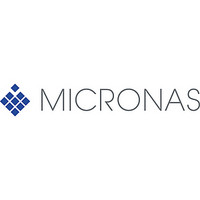MAS3587F Micronas, MAS3587F Datasheet - Page 11

MAS3587F
Manufacturer Part Number
MAS3587F
Description
MPEG Layer 3 Audio Encoder/Decoder
Manufacturer
Micronas
Datasheet
1.MAS3587F.pdf
(83 pages)
Available stocks
Company
Part Number
Manufacturer
Quantity
Price
Company:
Part Number:
MAS3587F-QI-B2
Manufacturer:
INTEL
Quantity:
101
ADVANCE INFORMATION
2.8.1. DSP Clock
The DSP clock has a separate divider. For power con-
servation it is set to the lowest acceptable rate of the
synthesizer clock which is capable to allow the proces-
sor core to perform all tasks.
2.8.2. Clock Output at CLKO
If the DSP or audio codec functions are enabled (bits
11 or 10 in the Control Register at I
6a
the synthesizer clock.
Dependent on the sample rate of the decoded signal a
scaler is applied which automatically divides the clock-
out by 1, 2, or 4, as shown in Table 2–1. An additional
division by 2 may be selected by setting bit 17 of the
Output Clock Configuration memory cell, OutClkConfig
(see Table 3–7 on page 34). The scaler can be dis-
abled by setting bit 8 of this cell.
The controlling at OutClkConfig is only possible as
long as the DSP is operational (bit 10 of the Control
Register). Settings remain valid if the DSP is disabled
by clearing bit 10.
2.9. Power Supply Concept
The MAS 3587F has been designed for minimal power
dissipation. In order to optimize the battery manage-
ment in portable players, two DC/DC converters have
been implemented to supply the complete portable
audio player with regulated voltages.
2.9.1. Power Supply Regions
The MAS 3587F has five power supply regions.
The VDD/VSS pin pair supplies all digital parts includ-
ing the DSP core, the XVDD/XVSS pin pair is con-
nected to the digital signal pin output buffers, the
AVDD0/AVSS0 supply is for the analog output amplifi-
ers, AVDD1/AVSS1 for all other analog circuits like
clock oscillator, PLL circuits, system clock synthesizer
and A/D and D/A converters. The I
own supply region via pin I2CVDD. Connecting this to
the microcontroller supply assures that the I
always works as long as the microcontroller is alive so
that the operating modes can be selected.
Beside these regions, the DC/DC converters have
start-up circuits of their own which get their power via
pin VSENSx.
Micronas
hex
), the reference clock at pin CLKO is derived from
2
C interface has an
2
C subaddress
2
C bus
2.9.2. DC/DC Converters
The MAS 3587F has two embedded high-performance
step-up DC/DC converters with synchronous rectifiers
to supply both the DSP core itself and external circuitry
such as a controller or flash memory at two different
voltage levels. An overview is given in Fig. 2–7 on
page 12.
The DC/DC converters are designed to generate an
output voltage between 2.0 V and 3.5 V which can be
programmed separately for each converter via the I
interface (see Table 3–3 on page 20). Both converters
are of the bootstrapped type which allow start up from
a voltage down to 0.9 V for use with a single battery or
NiCd/NiMH cell. The default output voltages are 3.0 V.
Both converters are enabled with a high level at pin
DCEN and enabled/disabled by the I
The MAS 3587F DC/DC converters feature a constant-
frequency, low noise pulse width modulation (PWM)
mode and a low quiescent current, pulse frequency
modulation (PFM) mode for improved efficiencies at
low current loads. Both modes – PWM or PFM – can
be selected independently for each converter via I
interface. The default mode is PWM.
In the PWM mode, the switching frequency of the
power-MOSFET-switches is derived from the crystal
oscillator. Switching harmonics generated by constant
frequency operation are consistent and predictable.
When the audio codec is enabled the switching fre-
quency of the converters is synchronised to the audio
codec clock to avoid interferences into the audio band.
The actual switching frequency can be selected via the
I
details see DCFR Register in Table 3–3 on page 20).
In the PFM operation mode, the switching frequency is
controlled by the converters themself, it will be just
high enough to service the output load thus resulting in
the best possible efficiency at low current loads. PFM
mode does not need a clock signal from the crystal
oscillator. If both converters do not use the PWM-
mode, the crystal clock will be shut down as long it is
not needed from other internal blocks.
The synchronous rectifier bypasses the external
Schottky diode to reduce losses caused by the diode
forward voltage providing up to 5% efficiency improve-
ment. By default, the P-channel synchronous rectifier
switch is turned on when the voltage at pin(s) DCSOn
exceeds the converter’s output voltage at pin(s)
VSENSn and turns off when the inductor current drops
below a threshold. If one or both converters are dis-
abled, the corresponding P-channel switch will be
turned on, connecting the battery voltage to the DC/
DC converters output voltage at pin VSENSn. How-
ever, it is possible to individually disable both synchro-
nous rectifier switches by setting the corresponding
bits (bit 8 and 0 in DCCF-register).
2
C-interface between 300 kHz and 580 kHz (for
MAS 3587F
2
C interface.
2
2
11
C
C













